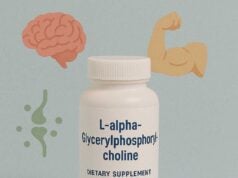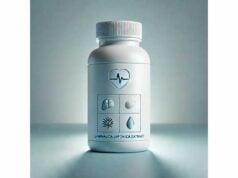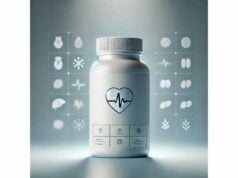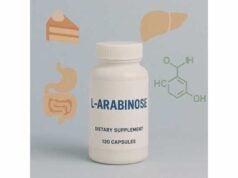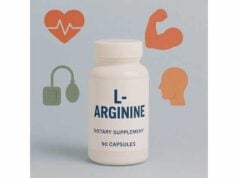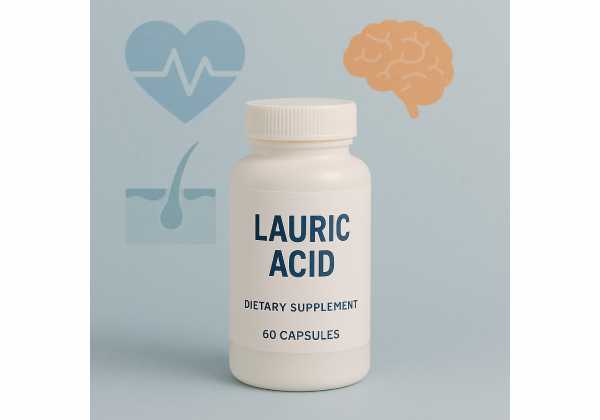
Lauric acid (C12:0) is a medium-chain saturated fatty acid best known for its abundance in coconut oil, palm kernel oil, and human milk. In the body and in formulations, it acts in two distinct ways. First, as a fatty acid, it fuels metabolism differently from longer-chain fats and can be incorporated into cell membranes. Second, when linked to glycerol as monolaurin (glycerol monolaurate), it displays notable antimicrobial effects in lab systems—disrupting lipid membranes of certain bacteria, fungi, and enveloped viruses. These properties have made lauric acid a favorite topic in nutrition and natural products, but the jump from petri dish to people is not automatic. Diet-wise, lauric acid counts as saturated fat, so heart-health guidance still applies: emphasize unsaturated fats overall, even if lauric acid behaves somewhat differently from longer-chain saturated fats. In topical care, lauric acid–rich ingredients can support cleansing and targeted spot products when used at sensible strengths. This guide separates hype from helpful detail so you can use lauric acid–containing foods, supplements, and skin-care products with confidence.
Key Insights
- Monolaurin (from lauric acid) shows broad antimicrobial activity in vitro and promising animal data; human clinical evidence is limited.
- As a dietary fat, lauric acid is still saturated; prioritize unsaturated fats and use coconut products in moderation.
- Practical ranges: monolaurin supplements commonly provide 300–1,200 mg/day in divided doses; topical lauric acid is often 0.5–5% in leave-on spots or higher in rinse-off cleansers.
- Avoid high-dose use if you have hyperlipidemia not at goal, uncontrolled cardiovascular risk, or if you are pregnant, breastfeeding, or giving products to infants without clinician guidance.
Table of Contents
- What is lauric acid and how it works
- Does lauric acid have proven benefits?
- How to use lauric acid in food and supplements
- Topical uses: how to apply safely
- Safety, risks, and who should avoid
- What the evidence says today
What is lauric acid and how it works
Chemistry and sources. Lauric acid is a 12-carbon saturated fatty acid (C12:0). It makes up a large share of coconut oil (commonly around 40–50%), appears at lower levels in palm kernel oil, and occurs naturally in human milk. In fats and oils, lauric acid is usually part of triglycerides (three fatty acids bound to glycerol). In supplements and cosmetic formulas, it may also show up as monolaurin (a single lauric acid bound to glycerol) or as sodium/lauryl esters used in surfactants and cleansers.
Absorption and metabolism (how your body handles C12). Medium-chain fatty acids (MCFAs) are often described as absorbing directly to the portal vein and heading straight to the liver for rapid oxidation. Lauric acid sits on the cusp between classic medium-chain (C8–C10) and long-chain behavior. It can use the portal route but also behaves more like a long-chain fat than C8 or C10 in some contexts. Practically, lauric acid is readily absorbed and oxidized, providing energy efficiently, but it is not metabolically identical to pure C8/C10 MCT oil. This distinction matters if you are choosing fats for metabolic goals or digestive tolerance.
From lauric acid to monolaurin (why it matters). When lauric acid is bound to glycerol to form monolaurin (glycerol monolaurate), the molecule gains surfactant-like properties that allow it to insert into and disrupt lipid membranes. In test systems, monolaurin disturbs the envelopes of certain microbes and can destabilize biofilms. This is a form-dependent effect; lauric acid alone shows antimicrobial actions too, but monolaurin is often more potent under lab conditions.
In cell membranes and signaling. As with other fatty acids, lauric acid becomes part of phospholipids and neutral lipids that make up cellular membranes. Its chain length and saturation help determine membrane fluidity and microdomain behavior. In immune and epithelial cells, lauric- and monolaurin-containing lipids can influence local signaling—some studies suggest modulation of cytokine patterns during infection models—yet these findings are still being translated for human use.
Industrial and formulation roles. Beyond nutrition, lauric acid’s chemistry makes it ideal for soaps, surfactants, and detergents: sodium laurate is a classic soap molecule that creates quick, voluminous lather. In skin and hair products, lauric-rich oils cleanse effectively but can be drying if percentages are high without emollients to balance them.
Bottom line. Think of lauric acid as a versatile building block: a readily oxidized fat in foods and a functional fatty acid that, when converted to monolaurin, shows interesting antimicrobial behavior in the lab. Its benefits depend on form, dose, and context—and it still counts toward your saturated fat total in the diet.
Does lauric acid have proven benefits?
Antimicrobial potential (strong in vitro, limited human trials). A large body of bench science shows that lauric acid and especially monolaurin can disrupt lipid-coated microbes. In cell culture and animal models, monolaurin has reduced replication of select enveloped viruses and weakened Gram-positive bacteria such as Staphylococcus aureus. Lauric acid itself has shown bactericidal activity against acne-associated bacteria in lab models and reduced inflammation in animal skin tests. Taken together, these findings justify topical and household uses and invite clinical research—but do not prove broad therapeutic effects in people. In everyday life, treat these actions as supportive rather than as stand-alone treatments for infections.
Skin and scalp care (practical, cosmetic benefits). In personal care, lauric-rich soaps and cleansers cut through oil quickly. Formulators often pair them with milder oils and humectants to prevent dryness. Small, targeted amounts of lauric acid or monolaurin in spot products may support clearer skin for some users, especially when combined with proven actives (e.g., niacinamide, adapalene) and a gentle routine. Because the skin barrier varies between people, patch testing is essential.
Oral health and hygiene. Lauric-containing surfactants provide foaming and cleansing, while monolaurin has shown activity against oral biofilms in vitro. In practice, choose fluoride-containing toothpastes for cavity prevention and consider lauric/monolaurin as adjunctive scent or cleansing components rather than substitutes for established oral-care agents.
Metabolic and energy uses. Compared with longer-chain fats, lauric acid is oxidized more quickly. Some athletes and low-carb eaters like coconut products for compact energy. However, most commercial MCT oils contain little to no lauric acid (they are typically C8 and C10), precisely because C8/C10 are more ketogenic. If you want lauric acid specifically, coconut or palm kernel–derived ingredients provide it; if you want rapid ketone production, C8/C10 MCT is a closer fit.
Cardiovascular profile (nuanced but conservative). Diets high in saturated fat raise LDL cholesterol. Lauric acid may raise HDL more than some longer-chain saturated fats do, but it still increases LDL, and major heart-health advisories recommend replacing saturated fats with unsaturated fats overall. Coconut food traditions can fit into healthy patterns in modest portions, especially when the rest of the diet is rich in vegetables, legumes, whole grains, fish, nuts, and olive oil.
Bottom line. Expect cosmetic and formulation benefits, and interesting lab-backed antimicrobial effects—strongest for monolaurin. For heart health, keep an eye on overall saturated fat, even when lauric acid is the source. For metabolic goals, distinguish lauric acid from C8/C10 MCTs and pick accordingly.
How to use lauric acid in food and supplements
Food-first approach. Lauric acid arrives in foods—primarily coconut products (oil, milk, cream, desiccated coconut) and palm kernel derivatives. If you enjoy the flavor and culinary properties, you can include them in moderation within a diet that leans on unsaturated fats (olive oil, nuts, seeds, fish). Practical ideas:
- Use 1–2 teaspoons of coconut oil to sauté aromatics, then finish dishes with olive oil for balance.
- For baking, replace only part of the fat with coconut oil to keep saturated fat reasonable while maintaining texture and aroma.
- Prefer whole coconut or light coconut milk in soups and curries when you want flavor with fewer total fats per serving.
Supplement forms and practical ranges.
- Monolaurin (glycerol monolaurate). Often sold in 300–600 mg capsules or scoopable granules. A common consumer range is 300–1,200 mg/day, split into 2–3 doses with food. Start low (e.g., 300 mg once daily for 3–5 days), watch for tolerance (GI upset is the usual complaint), then adjust only if needed. There is no standardized clinical dose for general wellness; higher intakes should be discussed with a clinician, especially if you take medications or have chronic conditions.
- Coconut oil softgels or powders. These deliver lauric acid but are simply another way to ingest saturated fat; they offer no special advantage over using small amounts of coconut oil in food.
- MCT oils (C8/C10). These are typically low in lauric acid. Choose them for rapid, clean-burning energy or keto strategies—not for lauric-specific effects.
Timing and stacking. If you experiment with monolaurin:
- Take with meals to reduce nausea.
- Do not combine with significant new supplements at the same time—you won’t know what caused benefits or side effects.
- Give any trial 2–4 weeks, track tangible outcomes (skin clarity, tolerance, energy, GI comfort), then keep only what clearly helps.
Who might consider a short monolaurin trial? Adults with robust baseline diets who are curious about adjunctive immune or skin support and are willing to track results. It is not a replacement for medical care, vaccines, or indicated treatments.
Who should skip supplements and stay with food? People managing dyslipidemia, cardiovascular disease risk, pregnancy, breastfeeding, children, and anyone with complex medication regimens should first discuss diet patterns with a clinician and rely on unsaturated fat sources, adding coconut flavors sparingly if desired.
Quality and labeling. Choose brands that disclose source oil, excipients, and assay (e.g., percent monolaurin). For coconut oils, look for freshness, refining method (virgin vs refined), and storage recommendations. Rancid or oxidized fats should be discarded.
Topical uses: how to apply safely
Cleansers and shampoos. Lauric-rich oils and their soap salts (e.g., sodium laurate) produce quick lather and strong cleansing—great for oily scalps and rinse-off bars, but potentially drying. If your skin feels tight after washing, rebalance with emollients (glycerin, squalane, ceramides) or choose a milder surfactant system.
Leave-on skin care (spot products). Lab studies show that lauric acid can inhibit acne-associated bacteria and ease local inflammation in animal skin models. In human routines, keep leave-on concentrations low and targeted:
- Spot gels/lotions: lauric acid or monolaurin 0.5–2% for small areas, once daily to start.
- Barrier-first approach: layer over a gentle moisturizer to reduce sting.
- Avoid large-area, high-percentage use—especially on compromised or freshly exfoliated skin.
Scalp and body oils. If you enjoy coconut-derived oils for glide and scent, dilute within a balanced base (e.g., 10–30% coconut or fractionated coconut oil blended with jojoba, sunflower, or squalane). For fine or easily weighed-down hair, use as a pre-shampoo treatment for 10–20 minutes, then wash.
Deodorants and household uses. Monolaurin appears in some deodorant sticks and sprays for its odor-neutralizing properties. As a laundry or surface fragrance note, it is fine—but do not rely on cosmetic concentrations when you need true disinfection.
Patch testing and escalation. Always patch test new leave-ons on the inner forearm for 24–48 hours. If clear, progress to a small facial area for several days before wider use. Stop at the first sign of persistent sting, redness, or rash.
What not to do.
- Do not apply high-percentage lauric acid or monolaurin to mucous membranes, eyes, or open wounds.
- Do not mix with strong irritants (retinoids, benzoyl peroxide, AHA/BHA) on the same night without a careful schedule.
- Do not use essential oils with high dermal irritancy as “solvents” for lauric acid—keep formulas simple.
When to get help. If acne is moderate-to-severe, cystic, or scarring, see a dermatologist. Lauric-based products can complement, but not replace, proven therapies like adapalene, benzoyl peroxide, or oral medications when indicated.
Safety, risks, and who should avoid
Dietary context (cardiometabolic health). Even though lauric acid has a distinctive profile among saturated fats, it still raises LDL cholesterol. If you have elevated LDL, familial hypercholesterolemia, diabetes, or multiple cardiovascular risk factors, prioritize unsaturated fats (olive, canola, nuts, seeds, fish) and limit coconut oil to small culinary amounts. Work with a clinician and dietitian to personalize targets.
Gastrointestinal tolerance. Adding new fats—or monolaurin—can cause nausea, cramping, or loose stools, especially when doses jump quickly. Start low, take with food, and stop if symptoms persist.
Allergies and sensitivities. True coconut allergy is uncommon but possible. Contact dermatitis can occur from fragranced surfactants associated with lauric derivatives in personal care. If you have a history of product reactions, favor fragrance-free options and patch test.
Pregnancy, breastfeeding, and pediatrics. Coconut foods are standard culinary items, but concentrated monolaurin supplements and high-percentage lauric leave-ons have insufficient safety data in pregnancy, lactation, and infancy. Stick to food forms in normal culinary amounts unless your clinician advises otherwise.
Medication and condition caveats.
- Lipid-lowering therapy: If you are taking statins or other lipid drugs, large increases in saturated fat intake can undermine goals; coordinate any diet changes with your care team.
- Liver or gallbladder disease: Any fat supplement may aggravate symptoms; use caution or avoid.
- Immune or infection management: Do not substitute monolaurin or lauric acid for prescribed antimicrobials or vaccines. At most, consider them adjuncts with professional oversight.
Topical-specific cautions. Lauric-rich cleansers can overstrip dry or eczema-prone skin. High-percentage spot products can sting. If irritation lasts more than 48–72 hours, stop and simplify your routine.
Simple rules that keep you safe.
- Diet: favor unsaturated fats; enjoy coconut flavors in modest portions.
- Supplements: if you try monolaurin, limit to 300–1,200 mg/day for 2–4 weeks, track results, and stop if no clear benefit or if side effects emerge.
- Topicals: keep leave-on lauric acid ≤2% for small areas; prefer rinse-off for larger areas; always patch test.
What the evidence says today
1) The lab picture is strong for antimicrobial effects—especially for monolaurin. Contemporary reviews and experimental papers document that monolaurin disrupts lipid membranes and can reduce viral replication and bacterial growth in vitro, with supportive animal data (for example, improved outcomes in certain piglet infection models). This biologic plausibility explains the popularity of monolaurin in deodorants, household sprays, and adjunctive wellness products. Translating those effects to consistent human clinical outcomes remains the next step; a few associations and pilot studies are emerging, but robust randomized trials are still limited.
2) For acne, lauric acid shows targeted promise—but mind the routine. In laboratory and animal skin models, lauric acid reduced Cutibacterium acnes and local inflammation, suggesting a role for low-percentage, leave-on spot products. Real-world acne care, however, benefits most from routines that combine gentle cleansing, non-comedogenic moisturizers, and evidence-based actives (adapalene, benzoyl peroxide), using lauric-based products as supportive—not sole—agents.
3) Cardiometabolic guidance continues to prioritize unsaturated fats. Major advisories evaluating decades of dietary fat research conclude that replacing saturated fats with unsaturated fats lowers cardiovascular risk. While lauric acid may raise HDL more than some saturated fats, its LDL-raising effect means it should not displace cardioprotective oils (olive, canola) in large amounts. Cultural cuisines can incorporate coconut judiciously within heart-healthy patterns.
4) MCT is not one thing: C8/C10 behave differently from C12. Many metabolic claims associated with “MCT oil” refer to C8/C10 products that contain minimal lauric acid. If your goal is ketone production or GI tolerability, C8/C10 often outperforms lauric-rich oils. If your goal is formulation, cleansing, or aroma, lauric sources shine—especially in soaps and rinse-off products.
5) Practical synthesis for everyday use.
- In the kitchen, enjoy coconut flavor within a pattern dominated by unsaturated fats.
- For supplements, a brief, low-dose monolaurin trial is reasonable for curious, healthy adults who track outcomes, but it is not a substitute for medical care.
- On skin, keep lauric leave-ons low and local; favor rinse-off formats for broader use; patch test first.
These points capture the balance of current knowledge: lauric acid and monolaurin are useful tools with specific strengths, best deployed with dose awareness and realistic expectations.
References
- Biomedical Applications of Lauric Acid: A Narrative Review 2024 (Review)
- Triglycerides of medium-chain fatty acids: a concise review 2022 (Review)
- Antimicrobial Property of Lauric Acid Against Propionibacterium acnes: Its Therapeutic Potential for Inflammatory Acne Vulgaris 2009 (Experimental Study)
- In vitro and in vivo antiviral activity of monolaurin against Seneca Valley virus 2023 (Experimental Study)
- Dietary Fats and Cardiovascular Disease: A Presidential Advisory From the American Heart Association 2017 (Guideline)
Disclaimer
This article provides general information and is not a substitute for personalized medical advice, diagnosis, or treatment. Always consult a qualified healthcare professional before changing your diet, adding supplements (including monolaurin), or starting new topical products—especially if you have high cholesterol, cardiovascular disease risk, liver or gallbladder disorders, are pregnant or breastfeeding, or are considering products for a child. Do not use lauric acid or monolaurin to replace prescribed medications or recommended vaccines. If you experience persistent irritation, allergic reactions, or worrisome symptoms after use, stop and seek medical care.
If this guide was helpful, please consider sharing it on Facebook, X (formerly Twitter), or your preferred platform, and follow us for more evidence-based health content. Your support helps us continue creating high-quality resources.

